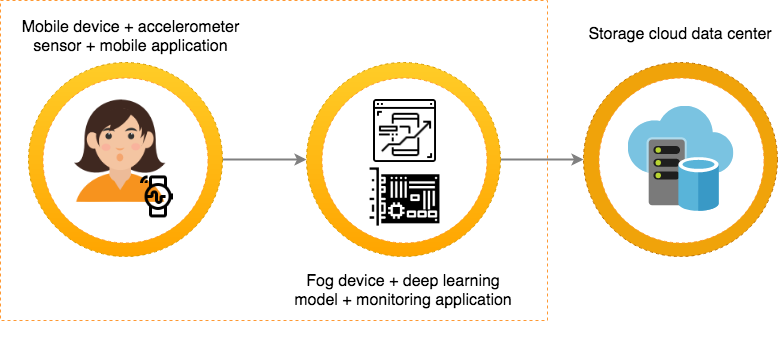Human falls are a global public health issue resulting in over 37.3 million severe injuries and 646,000 deaths yearly. Falls result in direct financial cost to health systems and indirectly to society productivity. Unsurprisingly, human fall detection and prevention is a major focus of health research. In this article, we consider deep learning for fall detection in an IoT and fog computing environment. We propose a Convolutional Neural Network composed of three convolutional layers, two maxpool, and three fully-connected layers as our deep learning model. We evaluate its performance using three open data sets and against extant research. Our approach for resolving dimensionality and modelling simplicity issues is outlined. Accuracy, precision, sensitivity, specificity, and the Matthews Correlation Coefficient are used to evaluate performance. The best results are achieved when using data augmentation during the training process.
- deep learning
- fall detection
- cnn
1. Introduction
This article focuses on the falls detection and addresses calls for more research on the use of deep learning analysis in healthcare. We consider deep learning for fall detection in a IoT and fog computing environment. We propose a Convolutional Neural Network (CNN) model, which we label CNN-3B3Conv, and evaluate its performance (i) against extant research on fall detection using a Long Short-Term Memory (LSTM) approach, and (ii) using three different data sets. Accuracy, precision, sensitivity, specificity, and the Matthews Correlation Coefficient (MCC) are used to evaluate performance in experiments.
2. Scenario
Figure 1 illustrates a use case for a IoT-enabled connected healthcare system for detecting human falls using a end device (embedded with an accelerometer sensor), a fog device, and deep learning. A user can have one or more IoT devices, for example a smartphone or smartwatch, that collect accelerometer data. This data is used to feed a trained deep learning model deployed in a local fog device. The IoT devices communicate with the fog devices through wireless technologies, such as IEEE 802.11, Zigbee, and Bluetooth Low Energy. In addition, the accelerometer data must be encoded using IoT communication protocols, such as Message Queue Telemetry Transport (MQTT) and Advanced Message Queuing Protocol.
Figure 1. Simplified fall detection use case
2.1. Proposal
The focus of this study is a deep learning model deployed at the fog device used to process the accelerometer data generated by the end user. We propose a CNN to extract relevant features from the data and detect if a fall occurred or not. Figure 2 presents the architecture of our CNN model, named CNN-3B3Conv.
Figure 2. CNN-3B3Conv model to detect fall from accelerometer data
Block 1 comprises a set of three sequential convolutional layers followed by one pooling layer. As we are considering sequential data, the model is designed with a one-dimensional convolution in the convolutional layers. For each convolutional layer, we configured a Rectified Linear Unit (ReLU) as the activation function and L2 regularization with alpha = 0.01 to reduce the overfitting. Moreover, we used 64 filters and a kernel size equal to four. After these three convolutional layers, there is a pooling layer used to merge semantically similar features, reducing the data dimensionality. We configured maxpooling with a pool size equal to three, and dropout with probability of 35% to reduce overfitting. These values were chosen empirically. Similarly, Block 2 comprises another set of three sequential convolutional layers and one pooling layer. However, the unique difference is the kernel size; which we configured to three. Finally, Block 3 comprises three fully-connected layers with 64, 32 and two neurons, respectively. The last layer has only two neurons reflecting the output of the model: whether the event is a "fall" or "not fall".
2.3. Results
Experimental results suggest that the proposed CNN model, CNN-3B3Conv, using data augmentation presents better results for fall detection compared to LTSM-Acc and LTSM-Acc Rot. Similar to [1], we could demonstrate that apply data augmentation technique improves the deep learning performance, both in terms of accuracy and precision. Dimensionality issues hampered the use of multiple data sets for evaluation, highlighting the need for large standardised data sets for comparative research validation. Notwithstanding this, once the CNN model was modified, performance was improved albeit with a simpler CNN model, the CNN-1Conv.
The article has been published on 10.3390/s19071644
References
- T. Theodoridis; V. Solachidis; N. Vretos; Petros Daras; Human Fall Detection from Acceleration Measurements Using a Recurrent Neural Network. World Congress on Medical Physics and Biomedical Engineering 2006 2017, 66, 145-149, 10.1007/978-981-10-7419-6_25.


